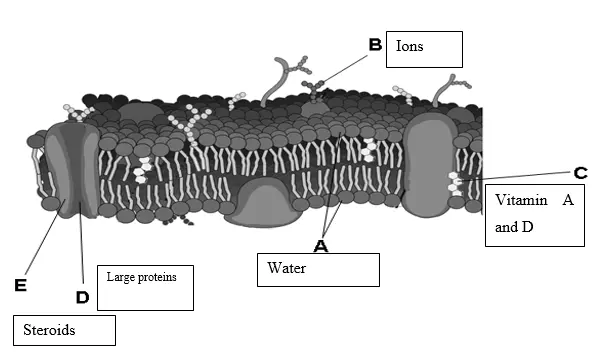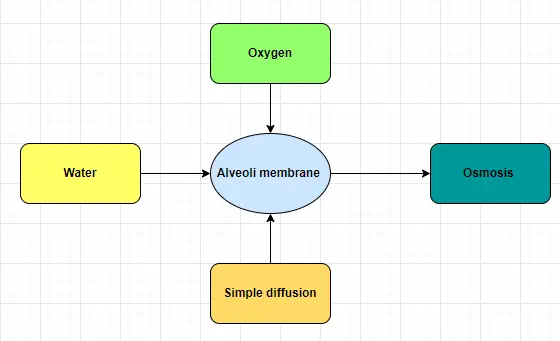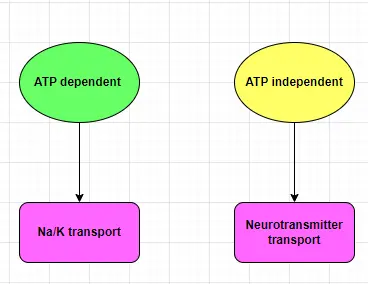In a eukaryotic cell, the mitochondria are often referred to as the “powerhouse” of the cell. This name is given to mitochondria because they are able to produce energy from the “ATP (Adenosine Tri Phosphate)” molecule (Grigaitis et al. 2020). This process of producing energy in the eukaryotic cells is called “cellular respiration”. In the process of cellular respiration one glucose molecule is broken down to form energy in the presence of an oxygen (O2) molecule. A mitochondria contains both an inner membrane and an outer membrane which provides a path for the protons molecule to travel across the organelles (Grigaitis et al. 2020). These proton molecules can create an energy potential that is used to break down the ATP molecule. Thus mitochondria produce the energy that is essential for every eukaryotic cell to grow.
In a eukaryotic cell, the ribosomes are mainly responsible for the synthesis of all kinds of protein molecules. In a ribosome, various steps occur that help to synthesize a protein molecule (He et al. 2020). These steps consist of “Transcription”, “Translation” and “Termination” of amino acids. An m-RNA that is present in a eukaryotic cell is translated into a protein molecule with the help of these three processes. In a ribosome, different kinds of peptide bonds are created between two amino acid molecules that help in the synthesis process of a protein molecule (He et al. 2020). Implementing all of these processes a ribosome helps a eukaryotic cell to synthesize a protein. These proteins which are produced in the eukaryotic cell have the ability to implement different kinds of processes in an organism.
A nucleus is the main eukaryotic cell organelle that helps to control all the activities of the other cell organelles that are present in a cell. It is also often described as the “command center” of a cell (McCoy et al. 2022). The nucleus helps a cell by controlling different types of cell activities, for example, the metabolism of a cell. It controls a cell's metabolism by implementing a DNA molecule's genetic information. The nucleus can also control the synthesis of the protein molecule in a ribosome.
The sperm cells also described as spermatozoa, are mainly considered as the sexual reproduction center of an organism. The main function of a sperm cell is to fertilize the zygotes of an organism (Ishiguro et al. 2020). The main specialized function of a spermatozoa is to provide all the genetic information of a male into a fertilized egg of an organism. It also consists of many mitochondria which help the sperm by creating energy for travelling through a female's body. After carrying all the genetic information into a fertilized egg a sperm cell helps to create a zygote (Brunet et al. 2023). This zygote contains a very unique genetic information which is partially different from the male’s genetic information.

Figure 1: Plasma membrane
Every eukaryotic cell consists of a plasma membrane which is made of a protein and lipid bilayer. The plasma membrane plays an important role in transporting various elements through the cell (Wild et al. 2019). These elements mainly consist of Water, large protein molecules, different kinds of steroids, various ions of a cell and a wide variety of vitamins. Water molecules travel through the lipid bilayer of a plasma membrane (Brunet et al. 2023). The lipid bilayer of a eukaryotic cell’s plasma membrane is made up of some hydrophilic parts. Because of this reason, the water molecule travels through this part (Wild et al. 2019). Different ions that are present in the cells travel through the ion channel of a plasma membrane. Mainly Vitamin A and Vitamin D pass through the hydrophobic tails of a plasma membrane. Every plasma membrane consists of different protein channels by which large protein molecules travel through the plasma membrane (Diaz-Hernández et al. 2019). This is the main part from which protein molecules travel through the cells of an organism. At last, the steroid molecule travels through the outer part of the protein channel. Oxygen and a water molecule both are able to travel through an “alveoli cell membrane”. They both move through the membrane with the help of a technique that is named “Passive transport”. However, the oxygen molecule uses a simple diffusion method to travel across the membrane (Díaz-Hernández et al. 2019). The water can't pass with the help of the simple diffusion method. It uses an osmosis technique to travel through the membrane.

Figure 2: Alveoli membrane transport
The transportation of Sodium and potassium ions mainly occurs through different kinds of ion channels that are present in the plasma membrane. This process happens with the help of an ATP molecule (Yamanaka, 2020). This ATP molecule helps by pumping the Na and K ions through a plasma membrane. However, the transportation of neurotransmitters is not dependent on an ATP molecule.

Figure 3: NA/K transport in plasma membrane
| Transportation methods | Description of methods | Energy-dependent | Active or passive transport |
| Osmosis | In an osmosis process water molecule travels through a plasma membrane. | No | Passive transport |
| Diffusion | In the diffusion process, highly concentrated solute travels to a low concentrated solute molecule. | No | Passive transport |
| Facilitated diffusion | Transportation of different molecules through a protein channel. | No | Passive transport |
| Endocytosis | A cell transports different kinds of materials by plasma membrane folding. | Yes | Active transport |
Table 1: Comparison of transportation method of plasma membrane
(Source: Self-created)
There are four different steps present by which the plasma membrane transports various elements across the eukaryotic cells (Yamanaka, 2020). This process consists of osmosis of water molecules, Simple diffusion of oxygen molecules, facilitated diffusion of different protein molecules, and endocytosis of different elements.
| Meiosis | Mitosis |
| The meiosis process occurs in the germ cells of an organism. | The mitosis process occurs in the somatic cell of an organism. |
| The daughter cell that is created in the meiosis process is haploid. | The daughter cell that is created in the mitosis process is diploid. |
| In the case of the meiosis process, no cross-linking between chromosomes occurs. | In the case of the mitosis process crosslinking between different chromosomes occurs. |
| Here four daughter cells are produced in this process. | In mitosis, two daughter cells are produced. |
| Different genetic disorders happen in the wrong meiosis process. | The dysfunction in the mitosis process can create cancer in an organism. |
Table 2: Comparison between meiosis and mitosis in eukaryotic cell
Get assistance from our PROFESSIONAL ASSIGNMENT WRITERS to receive 100% assured AI-free and high-quality documents on time, ensuring an A+ grade in all subjects.
(Source: Self-created)
After reaching adulthood a male organism continues to divide the body cells with the help of either the meiosis or mitosis process. In some cases, both of these processes are used at the same time (Brunet et al. 2023). The meiosis process occurs inside a male body after reaching the puberty age limit. It helps by producing the gametes inside of a male. All of the somatic cells are divided with the help of the mitosis process inside of a male human. Inside the body of a male adult different kinds of cells can be divided with the help of the meiosis process. This cell division process specializes in the formation of gametes in an adult male (Brunet et al. 2023). Through the process of forming gametes, it helps the male in reproduction. In most of the adult male meiosis creates haploid daughter cells from a diploid precursor cell. The tissues where the meiosis process occurs are mainly the germinal tissues of a male. These germinal tissues consist of the testicles of an adult male. This meiosis process starts with a diploid precursor parent cell. From this parent cell, four haploid daughter cells evolved in this process. Various kinds of genetic disorders evolve inside a male adult regarding dysfunction in the meiosis process. These genetic disorders are mainly “Down’s syndrome”, “turner syndrome” etc. In an adult male, the mitosis cell division process occurs in the somatic cells. It is the complete opposite process of meiosis because meiosis occurs in the germ cells. In an adult male mitosis plays a very important role in the growth of the body, by repairing tissues and also different types of “asexual production”. The tissues that are involved in mitosis mainly consist of different kinds of somatic tissues (Kharbikar et al. 2022). These somatic tissues consist of different types of skin tissues, various muscle tissues etc. Inside an adult male mitosis creates two diploid daughter cells from the precursor cell. It also helps by repairing different damaged tissues inside of a male body. The process of mitosis starts with the help of a nucleus in a male adult. If any type of malfunction occurs in the mitosis process it creates various diseases inside an organism. The most dangerous problem that is generated in an adult male is cancer.
There are many different organizations present that create a human body. The two most important organizations of the human body are the cell and the tissue. Every human body consists of millions of cells (Kharbikar et al. 2022). These cells are the smallest part of the human body. It contains multiple components inside of it. The most important cell organelles are the nucleus, the mitochondria, the cytoplasm, the plasma membrane etc. The combination of numerous cells creates a tissue inside a human body.
Inside a eukaryotic cell, a wide variety of stem cells present from which different kinds of other cells are generated. Stem cells are also described as raw cells. Stem cells have the ability to regenerate and repair different kinds of tissues inside an organism. It also plays a very important role in the “embryonic development” of an organism (Harris et al 2021). Various stem cells have the ability to replace aged cells. Inside the human body, a stem cell can generate a number of important cells for example the red blood cell, the cell of the liver, the cells of the nervous system and also the cardiac cells. “Hematopoietic stem cells” have the ability to produce red blood cells. These red blood cells are used in the bone marrow transplant process. The versatile nature of stem cells creates a very important research topic in the whole world. It also has various medical applications. Stem cells have various important roles in the medical and therapeutic industry. By implementing different methods on different stem cells, different tissue therapeutic techniques can be created (De Luca et al. 2019). This technique is very important in dealing with numerous heart diseases, spinal cord problems etc. The bone marrow transplant is also a very important medical discovery which is done by the use of “hematopoietic stem cells”. After implementing different techniques different kinds of personalized medicines are also created with the help of stem cells in the medicine industry (Fuchs and Blau, 2020). It also helps to understand a wide number of disease mechanisms. Stem cells also have an important impact on drug design. Various drugs can be tested on stem cells with a higher effectiveness. It also helps in the study of drugs in the laboratories. Stem cells also have various applications in the field of tissue engineering. With the help of stem cells various organs and tissues of an organ can be created in the laboratories (Fuchs and Blau, 2020) It is the most fundamental research tool in the field of genetics and biology. It helps us to understand the complex mechanism of an organism. Thus stem cells have become a very important part of the medical and therapeutic industry of the entire world. Various new medicines and disease management techniques are being created in the entire world after implementing various research on Stem cells. In the near future, different kinds of new techniques and medicines will also be developed by the researcher which can have effective results on those diseases which have no cure.
References
Journals
1. Introduction Achieve academic excellence with Rapid Assignment Help, offering expertly written and affordable Assignment Help...View and Download
INTRODUCTION Get free samples written by our Top-Notch subject experts for taking online Assignment...View and Download
Introduction Get Free Online Assignment Samples from UK's Best Assignment Help Experts to boost your academic...View and Download
Introduction Get free samples written by our Top-Notch subject experts for...View and Download
Introduction Get free samples written by our Top-Notch subject experts for taking online Assignment...View and Download
Introduction Elevate your academic performance with our personalized Assignment Helper, created to help you excel in every...View and Download
Copyright 2025 @ Rapid Assignment Help Services
offer valid for limited time only*

